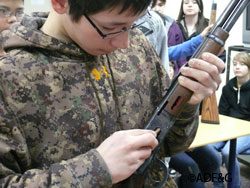Alaska Fish & Wildlife News
June 2010
The Way We Hunt
Itnuavva Anuniaguurugut

The Way We Hunt, a new hunting knowledge class for youth in Northwest Alaska was offered this spring at Kotzebue Middle High School. The class marks a stronger educational effort by the Alaska Department of Fish and Game (ADF&G) in Northwest Alaska to convey subsistence traditions and state laws regarding legal harvest and salvage of Alaska’s fish and wildlife.
The Way We Hunt, “Itnuavva Anuniaguurugut,” was taught cooperatively by representatives from Maniilaq’s traditional food program, respected elders and leaders from Kotzebue, Alaska Wildlife Troopers, Hunter Education Instructors, and biologists from ADF&G.
The goals of the class were to: (1) expose youth to information that will help them make good choices about their safety and respecting nature; (2) connect people within the community; (3) share traditional knowledge; and (4) emphasize the importance of harvesting in a legal and ethical manner.
Many components of this class were in alignment with those concepts taught in the state’s general hunter education class, but differed in that this class included local and traditional knowledge taught by respected community elders. It also did not provide students with a hunter safety card.
Students rotated through six sections during the day: firearm safety, wildlife management, safety and survival (indoor), safety and survival (outdoor), respectful hunting, and food care. Each section was 55 minutes long and consisted of a variety of hands on activities, student participation, visuals, and instructor led discussions.
Based on written evaluations and discussions with students, the class was a great success. Students and instructors thought the sections were engaging, interesting, and important. The target age group was 8th grade students, many of whom had already participated in some hunting activities. Many instructors felt that age of the students was very appropriate. One instructor commented that, “this is the age when student think they know how to do things because they have watched their family members hunt. It is a good time to reiterate safety to a group of kids who are about to begin taking over family hunting responsibilities.”

In the food care section, an instructor showed a video clip of her 13- year-old grandson harvesting his first caribou. She commented, “When these students are able to see someone their age harvesting caribou in a traditional and legal way, they can related to the experience and realize that they too can participate in this activity.”
The firearm safety section was popular because students were able to use cut-a-way firearms and practice proper handling and loading. They learned the importance of using the safety mechanism, keeping fingers off the trigger, target practice and sighting, essentials of cleaning, and why being safe and conscientious is so important.
The wildlife management section covered the important concepts of management such as; web of life, habitat needs, factors affecting populations, licenses and permits, what your license pays for , how regulations are made, and traditional methods of wildlife management (can’t use it don’t take it, self regulating in shortage, sharing). Students played a game where they pretended to be bears competing for limited resources, the game taught students concepts of habitat limitations and carrying capacity.
One stated that, “My favorite (section) was the survival skills outdoor because people can die from hypothermia, I am happy I learned what to do so I won’t die from freezing.” Students in this section learned to pack sleds, use GPS, water safety, and what to include in emergency packs and vests. In addition, students also heard stories from respected elders on near death experiences resulting from poor preparation. They learned outdoor safety tips, such as the importance of traveling with companions, letting someone know your route and destination, paying attention to weather, staying in one place when lost, and traveling with extra supplies.
The respectful hunting section addressed shot placement, shooting positions, ammunition choice, caliber choice, steel vs. lead shot, timing of hunting and migrations, respecting animals, and respecting habitat. Students engaged in discussions about how to avoid harassing wildlife and the importance of protecting habitat by keeping the ice and tundra clean. This section, taught by a local elder emphasized the importance of these concepts that encourage students to learn, ask questions, and think before engaging in hunting activities.

In the food care section students learned how to handle fish, birds, eggs, and meat in a traditional way. They also learned about healthy native foods and the importance of working hard to collect foods and preserve them for times of shortage. Students learned about the spiritual connection Inuit people have with the food and environment and the importance of tithing and giving back to the land. Instructors emphasized the importance of skinning in the traditional way that preserves the skins for use in mukluks and parkas. As this class develops, we hope to bring in actual game meat and teach students how to butcher and process fish, game, and birds.
Both students and instructors expressed interest in participating again and making this a required class at school, and hope to maintain it into the future either annually or seasonally, involve more elders and community members, and to take this class to as many different communities as possible. We also hope to focus on a variety of age groups, include more interactive activities, and use this experience as a way to encourage more people to take the State general hunter education class for certification.
This class was an important first step in engaging with members of the community, providing a service to the students in this region, and helping to fulfill ADF&G’s mission of education and cooperation with communities in rural Alaska in conveying subsistence traditions and State laws regarding harvest and salvage.
Meghan Nedwick is an outreach and education coordinator with the Division of Wildlfie Conservation in Kotzebue.
Subscribe to be notified about new issues
Receive a monthly notice about new issues and articles.
